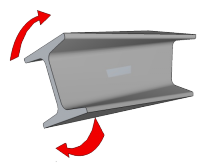Understanding Forces
From DT Online
There are many forms of structure: open frames, box construction, body shells, solid blocks, beams or animal skeletons for example. Structures are used to create bridges, dams, towers, cranes, houses, furniture, cars, aeroplanes, boats - in fact, many natural forms and just about every manufactured object we see in the world around us.

It is the job of structures to carry the loads for which they were designed without collapsing and to hold all the various parts in position.
Nature has achieved working structures such as trees, plants and animal skeletons by evolution but structural engineers prefer to achieve this by first understanding the forces within a structure - rather than have buildings collapse!
Even so, structural failures do occasionally occur and can sometimes be very dramatic.
When you sit on a chair or simply stand on a plank supported by a brick at each end for example, you are applying a static or dead load on to the structure. If however, you wiggle about on the chair, sit down suddenly, jump up and down or walk along the plank you are applying a dynamic or live load to the structure. These live loads may be many times greater than the dead loads and often much more difficult to deal with because they can involve sudden changes in size and direction. Strong winds for example can often be the cause of a structural failure.
All applied loads produce forces which have to be carried within the structure to a point where they can be resisted. The nature of forces was described and defined by Sir Isaac Newton in his Laws of Motion and, in recognition of this, the S.I. unit of force is known as a newton.
Note: By convention, units named after people are written in lower-case, but their abbreviations are capitalised

If you stand on bathroom scales for example, then all the downward forces are resisted by the internal upward forces generated inside the scales - e.g. by a strong spring. These upward forces are known as the reactions to the load.
If the scales (and the elephant!) are to stay still and not either sink or be sprung into the air, then the reactions must be equal and opposite to the forces caused by the applied load (Newton's 3rd Law).
In such a situation, the forces are said to be in Equilibrium.
So what is resisting both the elephant AND the scales - why don't they both fall through the floor?

The reason is that the floor, and all seemingly 'solid' things around us are not so 'solid' after all!
Matter is made of molecules and atoms which themselves are not so 'solid' but rather comprise a nucleus with electrons whizzing round and mainly, well, nothing in between! (This model of the atom first devised by Ernest Rutherford in 1909.)
So called 'solid' materials therefore are made up of atomic and sub-atomic particles that are just held together by chemical bonds, electrostatic forces and certain features of quantum mechanics (advanced readers may wish to check on the Pauli exclusion principle for example!)
For most of us, a more simple representation is to imagine 'solid' materials being made up of atoms and molecules held together by forces which can be thought of as springs. In this way, 'solid' materials behave in much the same way as bathroom scales, or a sprung mattress, to resist the applied loads - and that is why we don't fall through the floor!.

The forces which try to pull things apart, as if in a tug-o'-war, are known as tensile forces. The parts of the structure, or members, which contain these forces are known as ties. They are held in tension and need to be made from materials with good Tensile Strength.

The structural elements or members which contain forces trying to squash them or push them together, as if in a rugby scrum, are known as struts. They are held in compression and the forces are termed compressive. Struts need to be made from materials with good compressive strength.

Structures have to resist forces which try to make one part move in one direction and another part in the opposite direction - such as when scissors cut through paper.
These are known as shear forces and part of the designer's job is to make the parts strong enough to resist this shearing action. Fastenings such as bolts, rivets and welds, usually have to resist shearing forces to stop parts sliding past each other.
Torsion RSJ

Some structures may also have to resist twisting forces, or torsion, forces due to bending and sometimes structures are subjected to repeated vibrations resulting in forces being applied repeatedly which leads to complex patterns of Stress and consequent Strain.
The materials used to build structures must also resist the effects of these forces.
Repeated bending can lead to work-hardening such as when a thin strip of metal is repeatedly bent until it becomes so brittle that it breaks.
The detail design of the structural elements should avoid the danger of stress concentrations - unless intended. Stress concentrations can occur wherever there are cracks, scratches, sharp corners or a major change in cross section.
A bar of chocolate will break easily because it has 'cracks' designed into it to ensure this is so but, when not intended, such Stress Concentration can lead to catastrophic failures - as with the Comet air disaster in the 1950's for example.